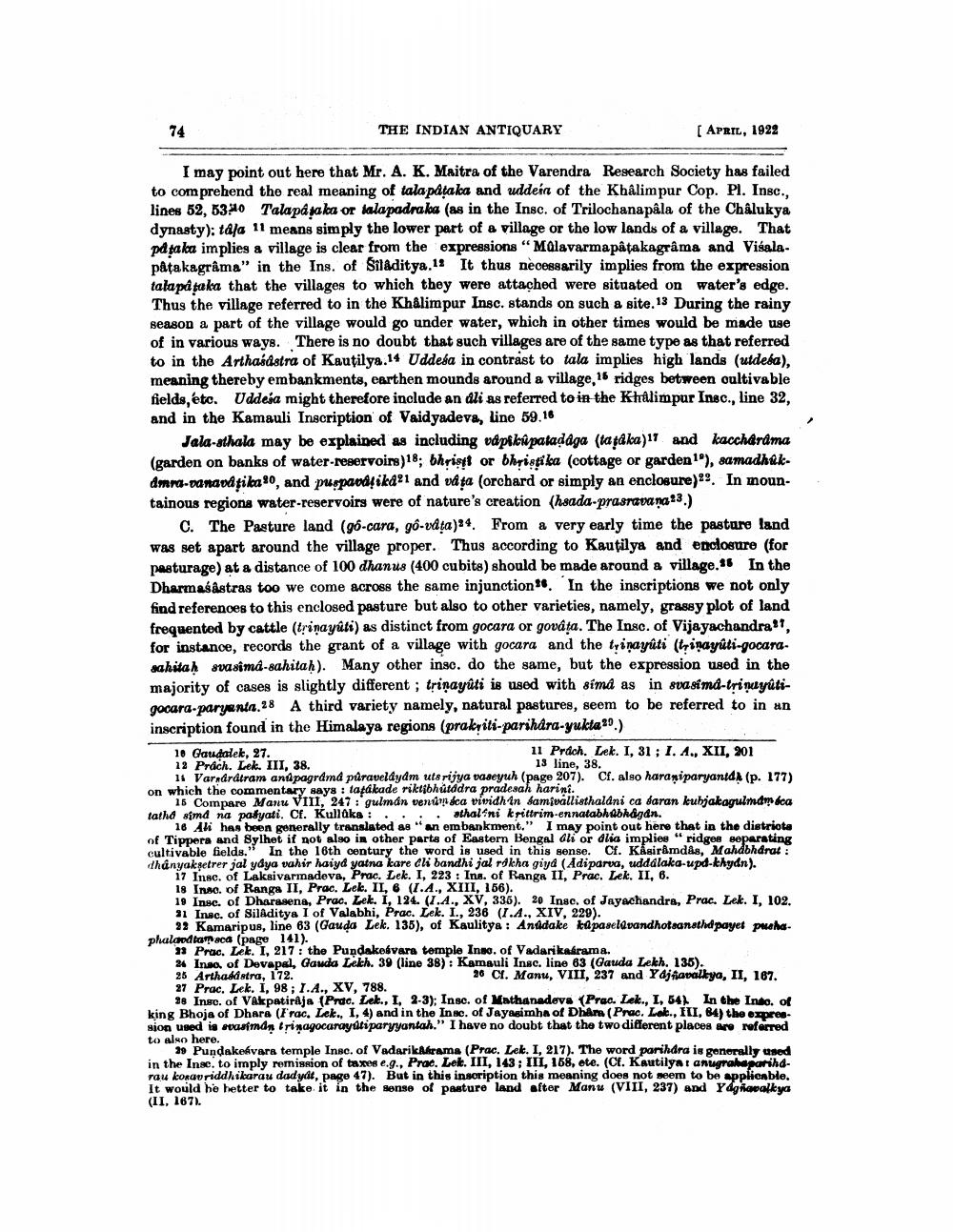________________
74
THE INDIAN ANTIQUARY
[APRIL, 1922
I may point out here that Mr. A. K. Maitra of the Varendra Research Society has failed to comprehend the real meaning of talapataka and uddeia of the Khâlimpur Cop. Pl. Insc., lines 52, 530 Talapaşaka or talapadraka (as in the Insc. of Trilochanapâla of the Chalukya dynasty): tala 11 means simply the lower part of a village or the low lands of a village. That pataka implies a village is clear from the expressions "Mûlavarmapâtakagrâma and Visalapâtakagrama" in the Ins. of Siladitya.12 It thus necessarily implies from the expression talapataka that the villages to which they were attached were situated on water's edge. Thus the village referred to in the Khâlimpur Insc. stands on such a site. 13 During the rainy season a part of the village would go under water, which in other times would be made use of in various ways. There is no doubt that such villages are of the same type as that referred to in the Arthasdstra of Kautilya.14 Uddesa in contrast to tala implies high lands (utdesa), meaning thereby embankments, earthen mounds around a village, 16 ridges between cultivable fields, etc. Uddesa might therefore include an ali as referred to in the Khalimpur Insc., line 32, and in the Kamauli Inscription of Vaidyadeva, line 59.16
Jala-sthala may be explained as including vapikupataḍága (tataka)17 and kaccharama (garden on banks of water-reservoirs) 18; bhristt or bhristika (cottage or garden 12), samadhikAmra-vanavatika 20, and puspavatika21 and vata (orchard or simply an enclosure) 22. In mountainous regions water-reservoirs were of nature's creation (hsada-prasravana 23.)
C. The Pasture land (go-cara, gô-vâța)24. From a very early time the pasture land was set apart around the village proper. Thus according to Kautilya and enclosure (for pasturage) at a distance of 100 dhanus (400 cubits) should be made around a village. In the Dharmasastras too we come across the same injunction. In the inscriptions we not only find references to this enclosed pasture but also to other varieties, namely, grassy plot of land frequented by cattle (trinayûti) as distinct from gocara or govâța. The Insc. of Vijayachandra"", for instance, records the grant of a village with gocara and the trinayûti (trinayûti-gocarasahitaḥ svasima-sahitaḥ). Many other insc. do the same, but the expression used in the majority of cases is slightly different; trinayûti is used with síma as in svasimd-triņayûtigocara-paryania.28 A third variety namely, natural pastures, seem to be referred to in an inscription found in the Himalaya regions (prakriti-parihara-yukta 29.)
10 Gaudalek, 27.
11 Prách. Lek. I, 31; I. A., XII, 201 13 line, 38.
12 Prách. Lek. III, 38.
11 Varsárátram anûpagrámá pûravelâyâm uts rijya vaseyuh (page 207). Cf. also haraṇiparyantáṛ (p. 177) on which the commentary says: tapákade riktibhütddra pradesah harini.
15 Compare Manu VIII, 247: gulmán venumsca vividhin samivallisthalani ca saran kubjakagulmaméca tathd simd na palyati. Cf. Kulluka: athalini krittrim-ennatabhabhágán.
18 Ali has been generally translated as "an embankment." I may point out here that in the districts of Tippera and Sylhet if not also in other parts of Eastern Bengal di or dlia implies "ridges separating cultivable fields." In the 16th century the word is used in this sense. Cf. Kasiramdas, Mahabharat: dhanyakṣetrer jal yaya vahir haiya yatna kare eli bandhi jal rokha giyd (Adiparva, uddalaka-upd-khydn).
17 Insc. of Laksivarmadeva, Prac. Lek. I, 223: Ins. of Ranga II, Prac. Lek. II, 6.
18 Insc. of Ranga II, Prac. Lek. II, 6 (I.A., XIII, 156).
19 Insc. of Dharasena, Prac. Lek. I, 124. (I.A., XV, 335). 20 Insc. of Jayachandra, Prac. Lek. I, 102. 21 Insc. of Siladitya I of Valabhi, Prac. Lek. I., 236 (I.A., XIV, 229).
22 Kamaripus, line 63 (Gauda Lek. 135), of Kaulitya: Anddake kapasel@vandhotsanstha payet pusha. phaladtamaca (page 141).
23 Prac. Lek. 1, 217: the Pundakesvara temple Inso. of Vadarikaárama.
24 Inso, of Devapal, Gauda Lekh. 39 (line 38): Kamauli Insc. line 63 (Gauda Lekh. 135).
25 Arthasástra, 172.
26 CI. Manu, VIII, 237 and Yajnavalkya, II, 187.
27 Prac. Lek. I, 98; I.A., XV, 788.
28 Insc. of Vakpatirâja (Prac. Lek., I, 2-3); Insc. of Mathanadeva (Prac. Lek., I, 54) In the Inso. of king Bhoja of Dhara (Frac. Lek., I, 4) and in the Insc. of Jayasimha of Dhara (Prac. Lek., HII, 84) the expres sion used is avasimán trinagocarayutiparyyantah." I have no doubt that the two different places are referred to also here.
39 Pundakesvara temple Insc. of Vadarikarama (Prac. Lek. I, 217). The word parihara is generally used in the Inse. to imply remission of taxes e.g., Prac. Lek. III, 143; III, 158, ete. (Cf. Kautilya: anugrahaparihdrau kosavriddhikarau dadyát, page 47). But in this inscription this meaning does not seem to be applicable. It would be better to take it in the sense of pasture land after Manu (VIII, 237) and Yagnavalkya (II, 167).




